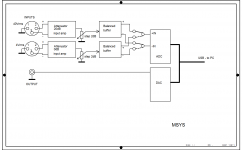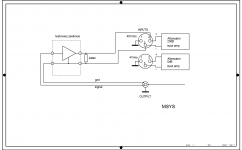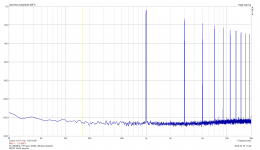Jan, read the other marketing literature of the "Modulus 86 R2" whose marketing slide is posted in #1380. It tells you there is NO mains hum thanks to the splendiferous world-beating PSRR of the composite amplifier. Ignore those peaks on the plot at F, 3F, and 5F; calculations assure us they cannot exist.
That does actually beg a question. I've seen many posts on here of the lengths people have to do to to remove spurious sources when bench testing, from turning off lights to running laptops on batteries. short of putting the DUT in a screened chamber (or 3 as per the usual LNA designs on here) has anyone managed to completely supress 50Hz and harmonics from their measurements? (honest question, even though 50Hz at -90dB is not something that ever worries me in a domestic setting).
Hi Bill, honestly, yes  . I lost my temper with wire nest diy card setups and built a small system recently. It covers input range 200mV - 40V with up to 20V balanced output.
. I lost my temper with wire nest diy card setups and built a small system recently. It covers input range 200mV - 40V with up to 20V balanced output.
Attachments
Last edited:
Jan, read the other marketing literature of the "Modulus 86 R2" whose marketing slide is posted in #1380. It tells you there is NO mains hum thanks to the splendiferous world-beating PSRR of the composite amplifier. Ignore those peaks on the plot at F, 3F, and 5F; calculations assure us they cannot exist.
I saw them on Bill's plot (60 Hz, 180 Hz).
Jan
The newer ADSL drivers are thermally designed with the application's crest factor in mind I guess.
Yes, when ADSL was heavily deployed the cabinets got too hot (1500W limit by law(?) or something like that) and we had to comply.
One could ask where Bill is getting 60Hz grid from?I saw them on Bill's plot (60 Hz, 180 Hz).
Jan
Not my measurement. Sadly I can't afford an AP. It's Tom's measurement of a board on the bench used purest Canadian electrons. I cannot comment if the mains spurs go if its all nicely boxed up as not seen a measurement of that. I still consider the performance adequate for my specific use case of active speakers in a small room. Doesn't meet all Pavel's requirements (and someone has started a thread to discuss those!) but it's not a universal powerhouse with optional arc welding attachements as some prefer.
Fit For My Purpose
Fit For My Purpose
This is all rather intresting and a lot of BS is flying about.
So I did a test of an amp that I was replacing caps and transistors in. I went through TEKs cookbook of audio tests.
My Square waves looked better than those links to Neurochrome's modulas 86 tests. Ok, I get it.
So, when I put it into my system for a listen... I almost went deaf from and ultrasonic blast... thanks to an overdesigned x-over in the Klipsch Cornwalls the tweeters didn't fry.
Then I got around to listening to the music.
It sounded like chit! Mac250, upgraded.
Maybe I should just let it burn in for a few weeks by itself with a load connected?
I've also Tested Film caps...(Present company excluded; i.e., Rel Caps) And these caps tested great from ESR, DA theta and quality... When used in an amp....they make the thing sound dull and lifeless. It's just Blaaaa.
So, what do we test for and how would it correlate to what we can hear, both as a lone component and integrated into our systems?
This is what Richard is saying and John also....
Then some of ya'll are saying all the old testing is irrelevant...or it's been done before, and on and on it goes.
Mark brought up some good stuff but I don't know which cmos blobs to use? Schematic please? No, it's not for college paper either . DPH or PMA did tests etc. SW says he did tests and designed ADICs and is published noted etc. Yes he did those things.
. DPH or PMA did tests etc. SW says he did tests and designed ADICs and is published noted etc. Yes he did those things.
So what is one to do?
Let's go to Chesky Budweiss for some real refreshment--who's buying?
In the mean time...I'm still putting my Bench area back together... and got stuff all over the piano room if I can't get it right in the soon, I'll be divorced with 4-3/4 year old kid.
She was caught teaching College Electronics class...check out her pic in my profile page.
Here is a better link. LINK
Here are the fine layout details she presented: LINK
And here also, LINK
Final link here: LINK
Cheers,
PostScript - diarriaha ([sp] - shariah come up with spell check) of the fingers again,
just can't seem to get rid of it neither Pepto-Bismol nor Immodium helped.
So I did a test of an amp that I was replacing caps and transistors in. I went through TEKs cookbook of audio tests.
My Square waves looked better than those links to Neurochrome's modulas 86 tests. Ok, I get it.
So, when I put it into my system for a listen... I almost went deaf from and ultrasonic blast... thanks to an overdesigned x-over in the Klipsch Cornwalls the tweeters didn't fry.
Then I got around to listening to the music.
It sounded like chit! Mac250, upgraded.
Maybe I should just let it burn in for a few weeks by itself with a load connected?
I've also Tested Film caps...(Present company excluded; i.e., Rel Caps) And these caps tested great from ESR, DA theta and quality... When used in an amp....they make the thing sound dull and lifeless. It's just Blaaaa.
So, what do we test for and how would it correlate to what we can hear, both as a lone component and integrated into our systems?
This is what Richard is saying and John also....
Then some of ya'll are saying all the old testing is irrelevant...or it's been done before, and on and on it goes.
Mark brought up some good stuff but I don't know which cmos blobs to use? Schematic please? No, it's not for college paper either
So what is one to do?
Let's go to Chesky Budweiss for some real refreshment--who's buying?
In the mean time...I'm still putting my Bench area back together... and got stuff all over the piano room if I can't get it right in the soon, I'll be divorced with 4-3/4 year old kid.
She was caught teaching College Electronics class...check out her pic in my profile page.
Here is a better link. LINK
Here are the fine layout details she presented: LINK
And here also, LINK
Final link here: LINK
Cheers,
PostScript - diarriaha ([sp] - shariah come up with spell check) of the fingers again,
just can't seem to get rid of it neither Pepto-Bismol nor Immodium helped.
Last edited:
It seems, we have Dunning & Kruger doing overtime.
Heern Gerhard:
I am sorry.
Es Tut mir Lied.
But this is from 1999 study which in part says:
"The Dunning–Kruger effect is a cognitive bias wherein people of low ability suffer from illusory superiority, mistakenly assessing their cognitive ability as greater than it is. The cognitive bias of illusory superiority derives from the metacognitive inability of low-ability persons to recognize their own...([Oxen-Scheisse], emphisis mine)."
Now at least we are on common ground and can move forward.
Cheers,
Sync, I can't get at what you're trying to explain wrt your testing/refresh of your old amp. Verified no oscillations (hopefully the square wave would have shown that), and did you get a frequency performance of the pre-mod? You may have just liked/got familiar with the old sound with dead caps.
On the other side, Dunning-Kruger's experiments have been validated in a number of orthogonal ways. One thing that's usually misinterpreted is that high performers *underrate* themselves, which is inaccurate; they tend to have a pretty good idea their capability. Similarly, those that are low-performers will largely rate their ability *less* than that of high-performers, but self-assess ability higher than their actual performance. So it's really a double blow of our ignorance makes us unaware of even our own limitations.
And notice the use of "us" and "our". This is an effect that hits everyone, as it's a domain-specific effect. I.e. even looking within EE, I probably suffer Dunning-Kruger in circuit design, power delivery, RF, communications, because I'm far more on the materials/fabrication side (and bleeding heavily into biological applications). Now I probably am more accurate about my ability in all the subdomains of EE than, say, something like ecology, where I don't even have a clue what I don't know.
And that's for every person in every field of expertise, albeit severity is highly variable within and between individuals.
On the other side, Dunning-Kruger's experiments have been validated in a number of orthogonal ways. One thing that's usually misinterpreted is that high performers *underrate* themselves, which is inaccurate; they tend to have a pretty good idea their capability. Similarly, those that are low-performers will largely rate their ability *less* than that of high-performers, but self-assess ability higher than their actual performance. So it's really a double blow of our ignorance makes us unaware of even our own limitations.
And notice the use of "us" and "our". This is an effect that hits everyone, as it's a domain-specific effect. I.e. even looking within EE, I probably suffer Dunning-Kruger in circuit design, power delivery, RF, communications, because I'm far more on the materials/fabrication side (and bleeding heavily into biological applications). Now I probably am more accurate about my ability in all the subdomains of EE than, say, something like ecology, where I don't even have a clue what I don't know.
And that's for every person in every field of expertise, albeit severity is highly variable within and between individuals.
Last edited:
I don't think this is linked to low-ability personalities. We all have the idea that we are better than the average guy, which of course is impossible - there should be roughly the same number of guys below average as above average.
Jan
Some of us know we are below average and live in fear of being found out.

I don't think this is linked to low-ability personalities. We all have the idea that we are better than the average guy, which of course is impossible - there should be roughly the same number of guys below average as above average.
Jan
No there should be a few more above
Some of us know we are below average and live in fear of being found out.
That would depend on the girl I think.
Jan
Mains hum - the last frontier...
We need a high-power SilentSwitcher.
Jan
Do you have mains hum and noise? Its easy to eliminate if you put the test equipment on an isolation transformer output. use battery power for computer, if you use one in testing.
here -- over head lights on, DUT in plastic box (no shielding) and no shielded PS wires. etc.
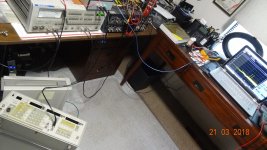
and yet very low levels being measured of gen+ dut HD. notice the missing line freqs. down to -150dbV.
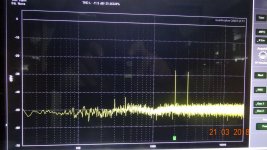
THx-RNMarsh
- Status
- Not open for further replies.
- Home
- Member Areas
- The Lounge
- John Curl's Blowtorch preamplifier part III
